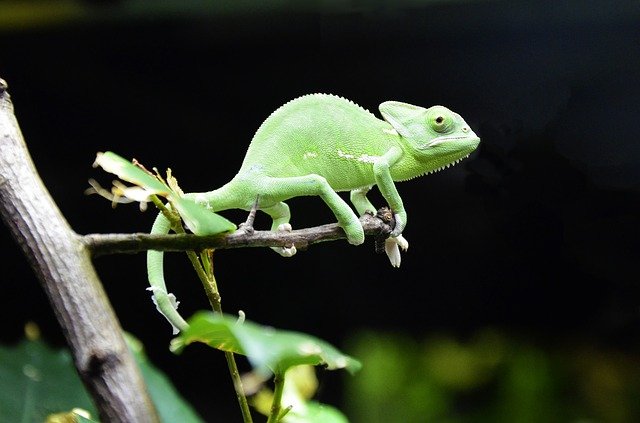Chameleons are not sociable animals and when they are in the wild, the only time that they will interact with other lizards of the same species is usually to fight or to mate. This means that when they are kept together in captivity, there is a potential that they will attack one another and potentially cause death to their tank-mate.
Introduction to Can Chameleons Kill Each Other?
If you’ve ever kept a chameleon as a pet, you may have looked at him all alone in his enclosure and thought about getting him a friend. But like many animal species, chameleons might not like to share their home.
Still, many pet owners go ahead and house two chameleons in the same tank and this raises the question of whether they will simply have a bit of a spat over whose part of the cage is whose or whether they could do some serious damage to one another.
In this article, we are going to be looking at whether chameleons can kill each other and whether they would take things that far if you keep them together in captivity.
Can You Keep Two Chameleons Together?
The short answer to this question is absolutely not! It is never a good idea to house two chameleons in the same enclosure because of how territorial they can be. If they are forced to share a space, it is highly likely that they will fight for dominance and in the worst cases, this could cause one of them to die, if the injuries are bad enough.
Your chameleons will want to exert their dominance over one another. The more dominant animal will take the first choice of basking locations, food, and other aspects.
But it is also important to remember that injuries and resulting death are not the only problems that your pets might face when living in the same cage.
This is because living together can cause them a lot of stress. Think of it in the same way as sharing a house with a messy person; you can keep cleaning up, but the mess will return and this ultimately leads to you feeling incredibly stressed. This is similar to two chameleons living together.
The more dominant animal will need to maintain its dominance and while it may look to you like everything is harmonious, your chameleon‘s stress levels could be soaring through the roof. Similarly, the stress for the less dominant animal will be just as great owing to the fact that they will feel as though they do not have a place to call their own.
When chameleons are stressed, this can have some very serious adverse effects on their physical and emotional well being.
Males And Females
In a lot of species, we see that it is possible to keep a male and female together but with chameleons, this is still not advisable. Mating for these animals is a very intricate affair and a female will begin to display certain colors to let a male know that she is ready to mate.
However, other than this, she will not need or want to be around a male and if forced to share an enclosure, there is a good chance that she will attack the male if he tries to pursue her.
If you do mate them, you must only introduce a male when the female signifies that she is ready to breed and even then, once the mating is over, you must remove the male. It is not uncommon for a pregnant female to develop aggressive traits and attack the male.
How Do Chameleons Interact In The Wild?
Chameleons are most commonly found in both desert and forest areas of Africa and one of their most notable traits is their ability to change color to adapt to their surroundings and camouflage. Chameleons have a lot of natural predators so they need this trait.
While some animals will protect themselves from predators by staying in larger groups, the chameleon does not behave in this way and instead, spends most of its life in solitude. The only time that chameleons ever come together is when they need to mate or if they are going to fight to defend their territory.
However, in the wild, it would rarely end in death because once one chameleon had won the battle, the loser would retreat and leave the area. But when these animals are kept together in an enclosed space such as a cage, there is nowhere for the submissive chameleon to go. This could cause the more dominant lizard to pursue his rival and cause further harm.
Keeping Different Breeds Of Chameleon Together
There is some speculation that it is possible to keep certain species of chameleon together. As a rule of thumb, you should always avoid keeping any type of chameleon with another. This is the best way to prevent fights because although some species are known to be more tolerant than others, there is always a risk.
If you must keep two chameleons in the same enclosure, it is best to go for dwarf chameleons or stump-tailed Brookesia chameleons since these are known to be the most tolerant of one another. However, you should remember to give them a large enclosure.
Keeping Baby Chameleons Together
If you are breeding chameleons, it may not be viable to have a separate cage for each of the young chameleons. But where you may not be able to keep adult chameleons together, this rule can be waived when keeping babies.
Typically, these animals will not develop territorial behaviors until they reach sexual maturity. You will still want to make sure that the babies have plenty of space to move around without getting on top of one another, but there won’t be any concern about fighting.
Once the chameleons reach four months old, this is an appropriate time to rehouse them and give them a space that they can call their own. However, you can push this a little further and continue to keep them in the same cage until they are eight months old. This is the age at which they will become sexually mature and where many owners will start to see problems if the chameleons are not separated.
It is not uncommon for chameleons to become stressed if they can merely see another chameleon. For this reason, it is advisable to keep the enclosures apart, if this is possible.
Conclusion
Chameleons may bond well with their owners but they certainly will not bond well with other chameleons. This is largely because they are hard-wired to defend their territory in the wild and this behavior will carry through when they are kept in captivity.
It is important to house your chameleons in separate cages; even better if these cages are not kept side by side as simply seeing another chameleon can be enough to upset these animals.
If you do keep them together, there is a high chance that they will fight and this could result in serious injuries. While for the most part, these injuries won’t be life-threatening, there is no getting away from the fact that chameleons could kill each other if left to fight for dominance.





